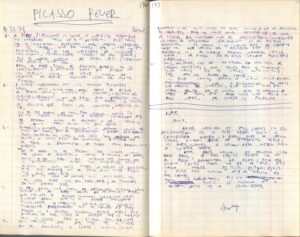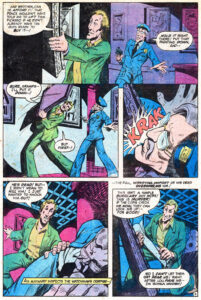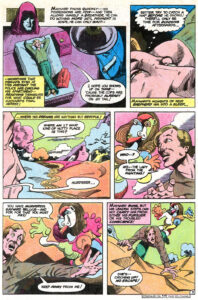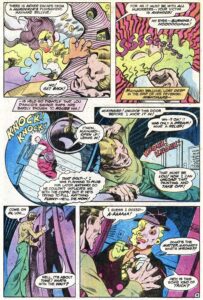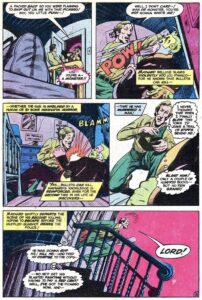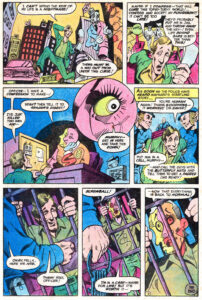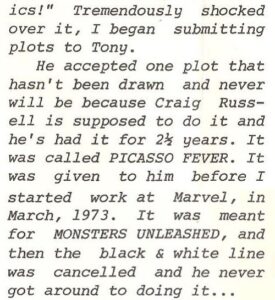Follow Scott
Recent Tweets
- Waiting for Twitter... Once Twitter is ready they will display my Tweets again.
Latest Photos
Search
Tags
anniversary Balticon birthdays Bryan Voltaggio Capclave comics Cons context-free comic book panel conventions DC Comics dreams Eating the Fantastic food garden horror Irene Vartanoff Len Wein Man v. Food Marie Severin Marvel Comics My Father my writing Nebula Awards Next restaurant obituaries old magazines Paris Review Readercon rejection slips San Diego Comic-Con Scarecrow science fiction Science Fiction Age Sharon Moody Stan Lee Stoker Awards StokerCon Superman ukulele Video Why Not Say What Happened Worldcon World Fantasy Convention World Horror Convention zombies
©2025 Scott Edelman
A Marvel Comics pitch becomes a DC Comics story
Posted by: Scott
Tags:
Posted date:
January 11, 2025 |
No comment
While digging through a box of papers from the ’70s in search of some information about my time at the 1979 Clarion Writers Workshop — which I needed as background for Episode 13 of my Why Not Say What Happened? podcast — I stumbled upon handwritten notes for a comics story which eventually appeared in the DC mystery book Secrets of Haunted House #11. And while studying my scrawl, I learned something surprising — more four years before “Picasso Fever” was published in that May 1978 cover-dated comic, I’d pitched it to Marvel for one of the company’s black-and-white magazines.
And not only that, but the date on those notes was April 21, 1974 — slightly more than two months before my start date at Marvel of June 24, 1974.
If you’d asked me last week when I’d begun pitching ideas to any of the Marvel editors, I’d have told you it wasn’t until after I was on staff, but here was evidence my memory was wrong, for I discovered multiple story ideas with accompanying notes indicating I was trying to sell to Marv Wolfman and Tony Isabella in March and April of 1974.
I decided to talk about this on Episode 14 of Why Not Say What Happened?, but thought it would also be interesting for comics historians to see that original plot compared with the story which eventually followed.
Why did Marvel editor Tony Isabella pass in 1974 and DC editor Paul Levitz eventually give me the go-ahead, even though for the most part, the early plot is almost identical to the later story? After all this time, there’s no definite answer for that.
It could be I was a better writer at age 23 in 1978 than I was at 19 in 1974, and the written pitch I submitted — which was obviously not the handwritten spread below — presented a better case, with more dramatic pacing and more descriptive word choices. Or it could be the eternal truth for all rejections — that the concept simply wasn’t right for Marvel’s books, but fit in with the DC editorial vision.
I suspect a little bit of both.
All this being said, I’ve transcribed my notes for a six-page story so you could read them against the story itself, which was drawn by John M. Fuller and Bruce Patterson. I hope those artists won’t feel disrespected if I mention the artist I had in mind as I wrote this was Alex Nino.
Here are those notes —
And here’s the front cover of that issue, where Michael Kaluta brought my concept to life —
First off, here’s my suggestion to Tony Isabella in 1974 that I needed seven rather than six pages to tell the tale, which would seem to indicate we’d had a prior conversation as to the proper length for this story.
Tony,
After looking at this story in its incarnation as a plot rather than a completed script, I feel that the story needs another page of breathing space. In other words, a seven-page rather than a six-page story.
Page three would be divided into two pages. The first (pg. 3) made up of the first paragraph of plot, and the second (pg. 4) made up of the rest. This would make pg 4, 5; pg 5, 6; pg 6, 7. I think this would help the pacing of the story.
It’s up to you, but I’d think it would be a better story as a seven-pager.
The story did eventually appear as a seven-page story, though with different pacing, as you’ll see.
And now — “Picasso Fever” — followed by a few thoughts on the differences between my initial concept and what readers eventually found on the newsstand.
Page 1
A thief, flashlight in hand, is walking through the darkened halls of a museum. The hall he is walking through has many statues in its center, and the walks are lined with paintings. It is not necessary to include well-known recognizable works in this scene, but the reader should be given an impression of beauty and age.
Louis, the thief, finds the painting which he is looking for — a painting done by Picasso in his “Public” style. The style which the majority of people associate with the name Picasso.
Page 2
A night watchman on his rounds discovers Louis. Louis, who had been about to place the frame down, swings it around, catching the night watchman on the jaw and breaking his neck. Louis sees that he is dead, and takes the painting off from its mounting, rolling it up.
Cut to: the dream of Louis that night. Louis is being chased through a Picasso landscape by the person who the portrait is of. Louis is the only “real” thing in this panel.
Page 3
Suddenly, another “Picassoian” is before Louis. He tries to run, but the Picassoian grabs for Louis’ face, covering his eyes, he can see through the hands, and Louis’ eyes are glowing. A knock at the door is beginning to wake Louis from his dreams.
At the door is the person for whom Louis had stolen the painting. Louis answers the door, only to see that his employer has turned into a “Picassoian.” When his employer pulls a gun on him, Louis grabs the rolled up painting, hits his employer on the jaw, and runs from his one room flat.
Cut to: a look of horror on Louis’ face, as he sees what lies on page four; the horrors of his present state.
Page 4
In this panel, we view the obscenities which Louis views in the last panel of the previous page. We can see a Picasso woman walking her Picasso dog. There is a Picasso newsboy selling paper. The headline of one says simply: “Watergate Breakthrough!” On the cover of that paper is a Picasso Nixon. Picasso birds fly through the air, while a Picasso cop is making out a ticket for a Picasso taxi-driver.
Page 5
Louis realizes that there must be a curse on the painting, a curse which will remain with him until he rids himself of the painting. He realizes jay hue but give himself up to lose the curse. He walks into the police station, where of course the policemen are drawn in the Picasso manner. As soon as Louis tells the sergeant that he had stolen the painting and is returning it, the world become normal once more. The face of the desk sergeant registers surprise.
Page 6
Louis, relieved, asks to be taken to his cell. The sergeant complies, and talks for a moment with Louis as he locks him in his cell. Then he turns to leave … and Louis begins a slow, multi-panel transformation into … a Picassoian. He does not realize the change, and will not be made aware of it until there is someone to react to him, but that will not occur in this story. The curse is fulfilled.
A few notes on the story my plot eventually became —
First, a relatively small change — in 1974, my protagonist’s name was Louis, while in 1978, that name was given to the buyer of the painting as Lou D’Amico, and the protagonist’s name was now Maynard Bellvue. (Which, I know, was a terrible name.)
A larger change — instead of simply swatting his buyer with the rolled up painting and running off, Maynard kills Lou with his gun, intensifying his crime.
I do wonder why I referred to Picasso’s Public style rather than his Cubist style. But, hey, what did I know — I was only 19, remember?
The story as published wisely doesn’t waste two pages on Maynard’s making up his mind to surrender to the police and then doing so. That space was better spent elsewhere, and so that sequence was condensed to a single page.
The published depiction of what Maynard sees out his front door in a Picasso world pretty much matches my earlier description save for one major change which I find amusing — no reference to Nixon or Watergate! Those were no longer top stories in 1978.
If you enjoy this kind of comic book minutiae, subscribe to Why Not Say What Happened? for much more!
UPDATE: Since originally uploading this post, I’ve solved a mystery — and come up with a new one. But let’s deal with the solution first!
Rereading a fanzine interview published during the summer of 1976, I was reminded of something I’d forgotten — that Tony Isabella had accepted “Picasso Fever” for publication … only Monsters Unleashed was cancelled before the assigned artist, P. Craig Russell, ever turned it in. And with the magazine dead, there was no need for him to draw it at all.
Too bad! I’d wish I could have seen what Craig would have made of it.
As for the new mystery …
While going through my papers, I found a complete script for a five-page version of this story dated February 2, 1974, more than two months before I sent Tony Isabella a six-page plot outline which I hoped to expand to seven pages.
What was that about?
Don’t ask me. I have no idea!

